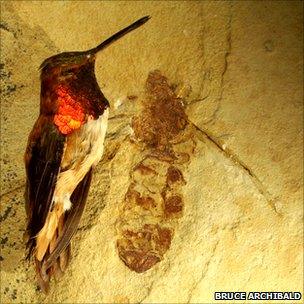Giant ants spread in warm climes
- Published

The fossil is of similar size to a hummingbird
A giant ant growing over 5cm (2in) long crossed the Arctic during hot periods in the Earth's history, scientists say, using land bridges between continents.
The ant, named Titanomyrma lubei, lived about 50 million years ago and is one of the largest ant species ever found.
Fossils were unearthed in ancient lake sediments in Wyoming, US.
Writing in the Royal Society journal Proceedings B, a Canadian-US team shows that giant ants, now and then, almost always live in hot climates.
The new species appears very similar to fossils found in Germany and in the Isle of Wight in southern England dating from the same period.
"We don't have any [fossils of] workers from this new species, we only have a queen," said Bruce Archibald from Simon Fraser University in British Columbia.
"It would have been very impressive - the one in Germany was estimated to have a body weighing as much as a wren, and this would have been of similar size," he told BBC News.
Little is known about how these ants lived or what they ate - but wings are present on the fossils.
They are found, in Europe and now in Wyoming, close to plants known to thrive only in temperatures around 20C (70F).
Road much travelled
The Eocene, 56-34 million years ago, was punctuated by periods when the Earth's temperature rose higher than it is today, probably because of the release of greenhouse gases such as methane into the atmosphere.
And the researchers believe that the giant ants must have made a journey from Europe to North America - or vice versa - during one of these "hyperthermals".

During the Eocene, continents were in different locations from those they occupy today
"There was plenty of life transferring between Europe and North America at that time - mammals, trees - all sorts of things," said Dr Archibald.
"And plenty of insects are similar between British Columbia and Denmark - but they could have lived in a cooler climate and crossed at any time.
"This is the first example we have of something that would have needed warmth in order to make the crossing."
The land bridges across the Arctic would have seen a temperate climate for most of the Eocene, rising during the hyperthermals.
During the course of the research, the team mapped the locations of all ant species, extinct or contemporary, growing longer than 3cm (1.2in).
They found that virtually all are associated with tropical temperatures, although the reason why remains a mystery.
The biggest extant equivalents are the driver ants of the Dorylus genus, found in Central and East Africa, which can also grow to 5cm long.
- Published30 September 2010